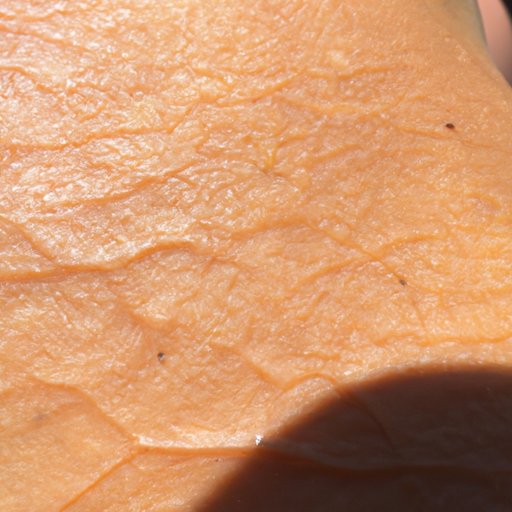Introduction
Crepe skin is a common condition that affects people of all ages. It is characterized by thin, loose, and wrinkled skin that typically appears on areas of the body such as the face, neck, arms, and abdomen. The condition can have a significant impact on a person’s self-confidence and quality of life, so understanding its causes is important.
In this article, we will explore what causes crepe skin through a medical perspective. We will examine the role of age, sun exposure, genetics, dehydration, and hormones in developing crepe skin. Finally, we will provide recommendations for preventing and treating crepe skin.
Analyzing the Causes of Crepe Skin Through a Medical Perspective
A variety of factors can contribute to the development of crepe skin. Let’s take a closer look at the most common causes:
Role of Age
As we age, our skin begins to lose elasticity and firmness. This natural process, known as elastosis, occurs when the collagen and elastin fibers in our skin become weakened over time. These fibers are responsible for giving our skin its shape and structure. As they break down, our skin becomes thinner, looser, and more prone to wrinkles, which can lead to crepe skin.
Impact of Sun Exposure
Excessive exposure to ultraviolet (UV) rays can also cause crepe skin. UV radiation causes damage to the skin’s cells, leading to premature aging and wrinkles. Additionally, UV radiation breaks down collagen and elastin fibers, further weakening the skin and making it more prone to crepe skin.
Genetic Factors
In some cases, crepe skin may be caused by genetic factors. For example, if a person has inherited genes that predispose them to crepe skin, they may develop the condition even without other contributing factors. Additionally, certain genetic mutations may make a person more likely to develop crepe skin.
Examining the Role of Age and Sun Exposure in Developing Crepe Skin
Let’s take a closer look at how age and sun exposure can contribute to the development of crepe skin.
Effects of Aging on Skin Structure
As we age, our skin loses its ability to retain moisture and produce new cells. This leads to dryness, which can cause fine lines, wrinkles, and sagging skin. Additionally, the production of collagen and elastin slows down, reducing the skin’s firmness and elasticity. Over time, these changes can lead to crepe skin.
Long Term Sun Exposure
Excessive UV radiation damages the skin’s cells and weakens collagen and elastin fibers, leading to wrinkles and crepe skin. Additionally, long term sun exposure can lead to hyperpigmentation, or dark spots on the skin. This can further worsen the appearance of crepe skin.

Exploring the Link Between Genetics and Crepe Skin
In some cases, crepe skin may be caused by genetic factors. Let’s take a closer look at how genetics can affect the development of crepe skin.
Inherited Genes
Certain inherited genes can increase a person’s risk of developing crepe skin. For example, a person who has a family history of crepe skin may be more likely to develop the condition themselves.
Genetic Mutations
Certain genetic mutations can also make a person more likely to develop crepe skin. These mutations can affect the production of collagen and elastin, leading to weakened skin structure and an increased risk of crepe skin.

Investigating the Relationship Between Dehydration and Crepe Skin
Dehydration can also play a role in the development of crepe skin. Let’s explore how lack of hydration affects the skin.
Lack of Hydration
When the body is dehydrated, the skin does not receive enough moisture. This can lead to dryness, which makes the skin more prone to wrinkles and crepe skin.
Dryness of Skin
Dry skin is prone to wrinkles and crepe skin because it lacks the elasticity needed to keep the skin taut and smooth. Additionally, dry skin is more vulnerable to UV radiation, which can further weaken the skin and lead to crepe skin.

Understanding the Impact of Hormones on Crepe Skin
Hormonal changes can also affect the development of crepe skin. Let’s take a closer look at how hormones can influence the condition.
Changes in Hormonal Levels
Changes in hormonal levels can affect the production of collagen and elastin, leading to weakened skin structure and an increased risk of crepe skin. Additionally, hormonal imbalances can lead to dryness, which can also contribute to the development of crepe skin.
Effects of Stress
Stress can also affect the production of hormones, leading to an increased risk of crepe skin. Additionally, stress can cause dryness, which can further worsen the condition.
Conclusion
In conclusion, crepe skin is a common condition that can be caused by a variety of factors. Age, sun exposure, genetics, dehydration, and hormones can all play a role in the development of the condition. To prevent crepe skin, it is important to protect the skin from UV radiation, maintain adequate hydration, and manage stress levels. Additionally, treatments such as retinoids, laser resurfacing, and chemical peels can help reduce the appearance of crepe skin.


